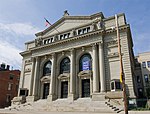Colored Industrial School of Cincinnati
Colored Industrial School of Cincinnati (also known McCall School and McCall Colored Industrial School) was a school for African Americans in Cincinnati, Ohio. It was established in 1914 at 724 W. Sixth Street.The school was established on property donated by Sallie J. McCall in her 1909 will. A trade school, courses included carpentry, masonry, cement work, automobile mechanics, driving, domestic science, dressmaking, and millinery. Through a $400,000 endowment McCall established, equivalent to $11,686,379 in 2022, the school did not charge tuition. Between 1914 and 1926 it had 600 graduates. In the 1930s it was relocated to 1301 John Street. Several years after Robert A. Taft Information Technology High School opened nearby, in 1962 Colored Industrial School of Cincinnati closed. Scholarships were established for African American students with the endowment's remaining funds.
Excerpt from the Wikipedia article Colored Industrial School of Cincinnati (License: CC BY-SA 3.0, Authors).Colored Industrial School of Cincinnati
Ezzard Charles Drive, Cincinnati West End
Geographical coordinates (GPS) Address Website Nearby Places Show on map
Geographical coordinates (GPS)
| Latitude | Longitude |
|---|---|
| N 39.108333333333 ° | E -84.523333333333 ° |
Address
Robert A. Taft Information Technology High School
Ezzard Charles Drive
45210 Cincinnati, West End
Ohio, United States
Open on Google Maps








